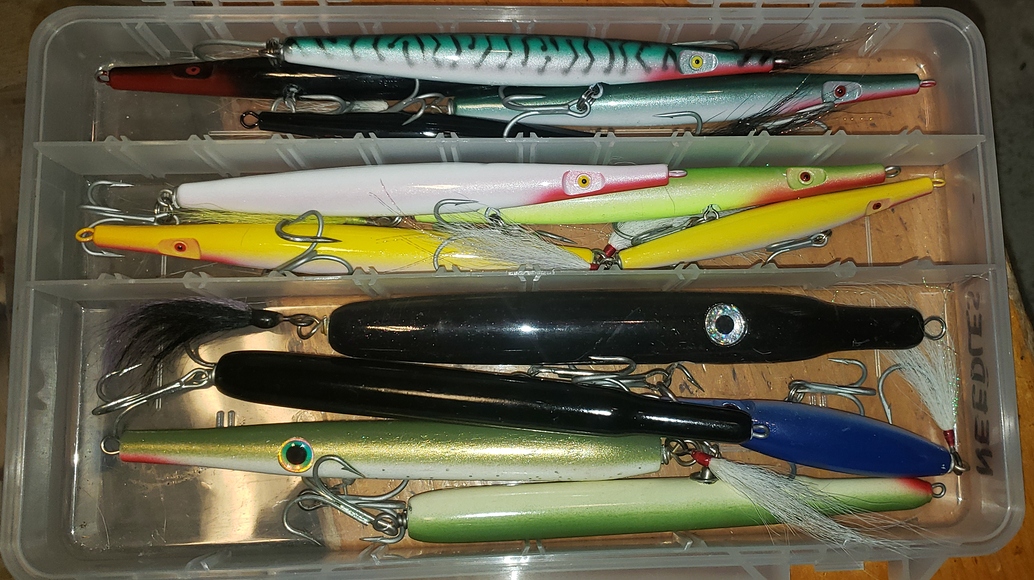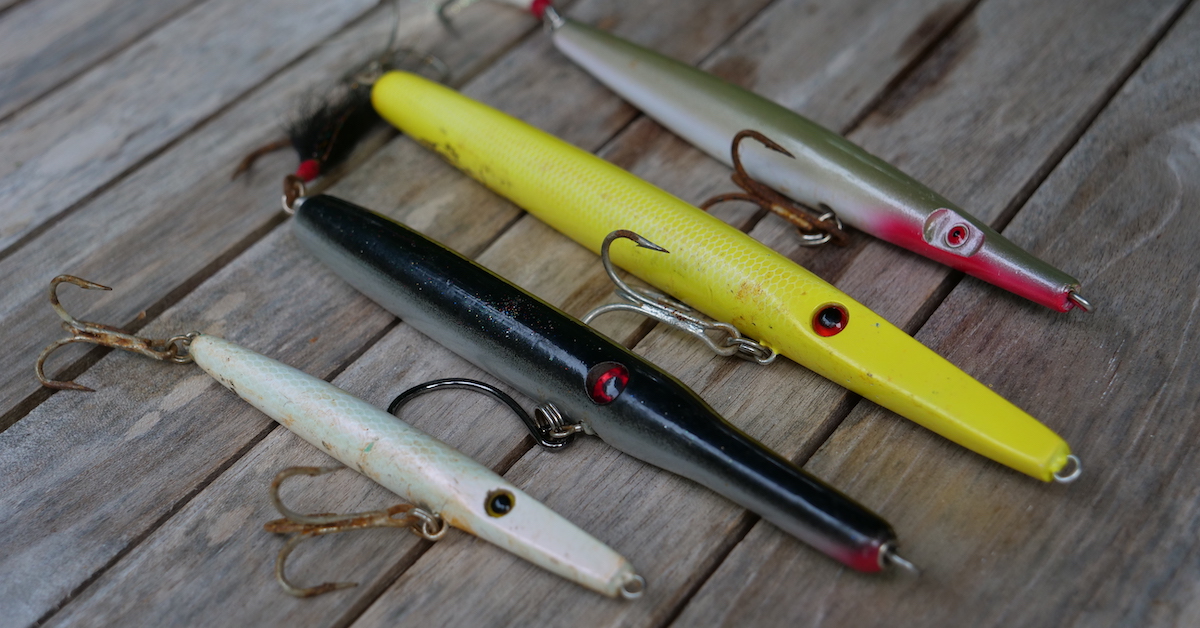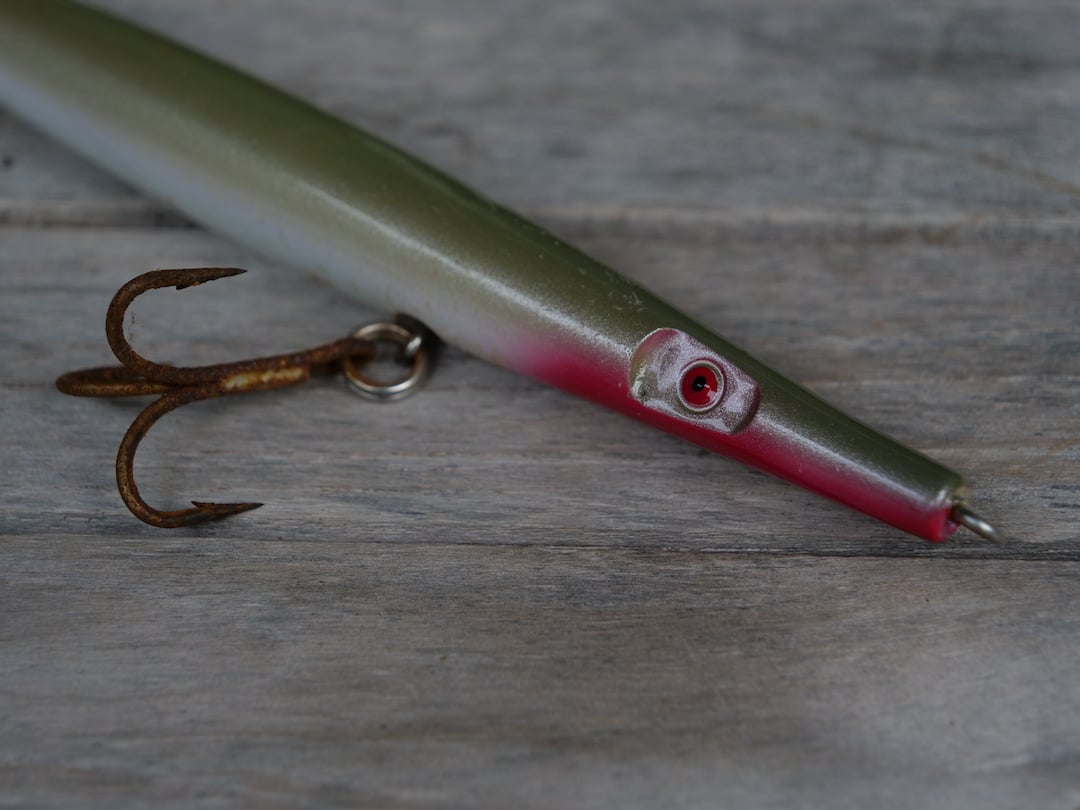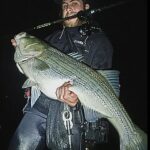This post was originally published in September of 2020 and has been updated for the 2024 season.
Needles rank as one of the most versatile plugs in the surf casters arsenal, and they are simplistic in design.
For all intents and purposes, a needle is simply a weighted, tapered plug of wood or plastic, with no inherent or inbuilt action.
This lack of any existing action is what makes the needle so deadly, and so versatile as a surf plug. The angler has complete control over the plug, which means that needles can be a great choice in a variety of situations.

Needlefish Types: Sinking vs. Floating
Most needles sink, either at a slow, moderate, or fast rate of speed-depending on the build and style. Some plug builders also make floating variations of the needle, an option that can be deadly in certain conditions (for instance when fishing a shallow-flooded boulder field with moderate sweep).
That said, sinking needles are generally the most versatile choice for most surf anglers. Luckily for us the number of builders and styles of needlefish plugs on the market means that there is an option for almost every condition, from shallow boulder fields, to deep outflows, to casting into heavy onshore winds and big surf.

The trick of course is in choosing what needle to toss in a particular situation. I generally find slow or moderate sinkers to be the most versatile from most beaches and boulder fields.
Heavier, fast sinkers are a good choice when targeting deeper waters, or when extra long casts are necessary to reach the fish or structure. Stubby weighted needles are my go-to when casting into sloppy conditions, or when it’s necessary to cut through the wind.
Different Needlefish Retrieves
When fishing a needle I’ll usually start with a slow steady retrieve, with the occasional pump or twitch of the rod tip. This slow and subtle approach is often all it takes to get the job done......
When fishing a needle I’ll usually start with a slow steady retrieve, with the occasional pump or twitch of the rod tip. This slow and subtle approach is often all it takes to get the job done.
If that doesn’t produce, then I’ll begin to mix up my retrieval methods until the fish tell me what they want. You can try incorporating longer sweeps and pauses, bouncing the bottom with your plug, dead-sticking it in current with only the slightest retrieve to keep tension on the line, or working it aggressively in the upper water column.
Here is a video from Ryan of MFCC demonstrating a slow and steady straight retrieve, in which he imparts almost no added action at all.
The only wrong retrieve with a needlefish is the one that doesn’t catch fish. The great thing about using a needlefish is that the retrieve and the action is entirely up to the angler and that really gives the surfcaster the power to dial the plug into the fish.
A good rule of thumb when fishing needles in the surf (and all plugs in general) is when in doubt, slow it down. There is almost no such thing as a retrieve that is too slow. As long as you keep tension on the line, then you can crawl that plug through the surf and the fish should respond favorably.
What might feel painfully, painfully slow to the angler is probably just right for that cow which is looking for an easy meal.
The Super Strike Needlefish
If you’re interested in getting your hands on a few needles, then I would highly recommend checking out the Superstrike needles. Unlike many custom needles the SS has a plastic body, which means they are extremely consistent, durable and a great place to start experimenting.
SS needles come in a couple of sizes and a handful of different weights, easily distinguishable by their eye color. Yellow eyes for the more moderate sinking plugs and red for their heavy, fast sinking options.

A yellow eye SS will usually be in my bag when fishing open sandy beaches or boulder fields. I’ll pack along a heavy red eye or stubby SS bullet when targeting deep outflows, when casting against heavy winds and big surf, or any time extremely long casts are necessary.
It’s also worth noting that because of their excellent casting ability and their versatile retrieve, needles serve as a great plug to deliver a teaser into the surf.
A needle teaser combo can be an extremely deadly rig when the bass are finicky, and small bait or sand eels are the primary forage.


A much needed article Calvin, many anglers stay away from Needles after experiencing a few nonproductive outings. They are one of my favorite plugs and have many more applications then just environs where sand eels might be present. They are also the perfect delivery system to attach a teaser to which solves the problem of bass that are only feeding on small bait. Often when fishing a needle I imagine that I am “live lining” the plug, using an extremely slow retrieve and small windows of not reeling at all which is when most hits will happen. Also, a shake of the rod will often initiate a strike better than a twitch. This low impact technique works extremely well at night. Observe the behavior of a group of baitfish the next time you happen on them in the shallows at night. Bait fish are usually doing two things, trying to conserve energy and not get noticed and thus eaten. A steady retrieve does not replicate this behavior as well.
When using a slow or no retrieve, the weight, or sinkability of the plug should be matched with the aspects of where you are fishing such as depth, current, wave action, and obstructions. You don’t want to have your plug sink to the bottom when you stop or slow your retrieve and get hung up. If you have to reel fast to keep your lure from getting snagged then that becomes the basis for your presentation, not what will reach the fish or most effectively generate strikes.
I have a problem keeping tension on the line when fishing needlefish (or any other plugs) in heavy surf. The waves push the plug in fast.
Would you use needlefish in these conditions or switch to a bucktail?
I am far from a needlefish expert Ken, but if the surf is really big, then a heavier, sinking needlefish will make it easier to keep tension on the line, as opposed to using a lighter version. A bucktail would also do the trick. LMK if I can help answer anything else. Hope all is well down south!
Thanks for passing along your experience Calvin!
Very useful info, thanks!
I’ve got needles in my surf bucket but haven’t until now known what to do with them.
The great thing about needles is that you get to decide exactly what you do with them. Good luck out there!
I’m getting a needlefish tattoo.
Great read. I’ve had just a few incredible sunrises using a bullet needle getting out over the third wave for the beach. But probably blind luck on a very slow retrieve. This is great information!
Well done Calvin, you are definitely wise beyond your years. Thanks for sharing your knowledge.
Appreciate the kind reply. I’ve fortunate to have been able to put in quality time on the water with some great teachers and I always enjoy sharing a little bit of what has worked for me in turn. Tight lines!
Excellent article Calvin!!! KEEP THEM COMING! !!
Thanks! I appreciate the kind words.